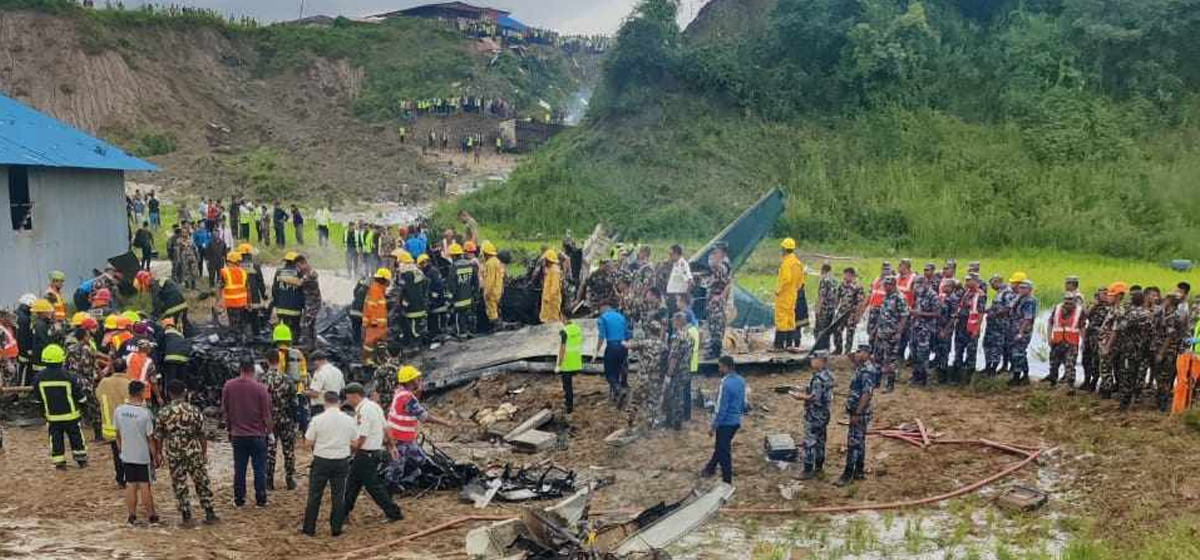Toastmasters Nepal celebrates Citation 2024
5 days ago
We are a team of professional management and journalists — one of the best in the Nepali media. Our duty toward our readers is to provide them with impartial news, bold views, in-depth analysis and thought-provoking commentary. We shall do this without fear or favor, and we shall be guided by nothing but our conscience.
Know More
In yet another tragedy involving the Nepali aviation sector, an aircraft belonging to Saurya Airlines—a private sector airline company—bound for Pokhara met with a tragic accident at Tribhuvan International Airport in Kathmandu. Eyewitnesses reported that the aircraft, with 19 people including crew members on board, crashed seconds after takeoff from TIA at around 11 AM on Wednesday. While the captain was safely evacuated, the remaining 18 passengers and crew were confirmed dead. The deceased included Saurya Airlines staff and their family members. In response to the tragedy, the government decided to lower the national flag to half-mast on Thursday to mourn the loss of lives. Additionally, a five-member commission has been formed to investigate the causes of the accident.
The commission, led by Ratish Chandra Lal Suman, former director general of the Civil Aviation Authority of Nepal (CAAN), includes Captain Dipu Jwarchan, professors Kuldip Bhattarai and Sanjay Adhikari from Pulchowk Engineering Campus, and Air Traffic Control Officer Mukesh Dangol. They have been given 45 days to submit their report. These prompt actions on the part of the government give an impression that the government is seriously concerned about the accident and determined to take concrete measures to prevent such accidents. But there is little reason to be hopeful yet, as almost all commissions in the past have prepared reports that are shelved and forgotten, allowing air accidents to become a regular occurrence. This must stop. Government agencies and regulatory bodies must take decisive actions to prevent such accidents in the future.
Almost all previous air crash investigations have cited weak regulatory oversight, commercial pressure, and failure to follow procedures by flight crews. These points were largely ignored, leading to a distressing repeat of deadly controlled flight into terrain (CFIT) occurrences over the years. Almost every past investigation blamed the violation of flying Visual Flight Rules (VFR) in the mountains as the primary reason for crashes. Crews underestimated the severity of deteriorating weather en route or at the destination, were often overconfident, or did not comply with the standard operating procedures. Inadequate crew training has often been cited as one of the reasons for fatal accidents.
The CAAN in its capacity as the government’s regulatory body has largely failed to play its regulatory role in these areas. The actual reason for the Saurya Airlines crash on Wednesday will have to await the analysis of the Flight Data Recorder (Black Box) and Cockpit Voice Recorder. However, the fact that the plane crashed seconds after takeoff suggests there might have been mechanical issues with the aircraft, possibly due to weak regulatory oversight. We can assume that the captain, with experience of several thousand flying hours, may not have made mistakes that could lead to such a tragedy within seconds after takeoff.
Following a 2017 audit by the International Civil Aviation Organisation (ICAO) that gave a passing score, there was optimism in Nepal that our airlines would eventually be removed from the EU Aviation Safety Agency blacklist. However, the Tara Air crash in June 2022, the Yeti Airlines disaster in January 2023, and now the Saurya Airlines disaster could further delay European certification. The emergency cabinet meeting on Wednesday decided to make domestic airlines responsible for regular testing of their aircraft, with CAAN conducting intensive monitoring. This is a step in the right direction, but it is not enough. Nepal has failed to take even the bare minimum steps to make its skies safer. The most obvious solution is to split the CAAN, which currently acts both as a regulator and a service provider.
This dual role has created a significant conflict of interest, undermining its role as the regulator of the country’s aviation sector. As a regulator, CAAN is supposed to ensure the airworthiness of all aircraft flying domestic routes, directly related to passenger safety. But as a service provider, it operates all of the country’s airports, with profit maximization as its goal. This coupling of passenger safety and profit maximization is having serious unintended consequences. The government must work towards splitting CAAN, limiting the body exclusively to its regulatory function. This can significantly improve its regulatory functions, improving the safety of Nepali skies. It is high time our politicians and policymakers asked themselves a crucial question and engaged in soul-searching: How long can we afford to see such tragedies continue?
Leave A Comment